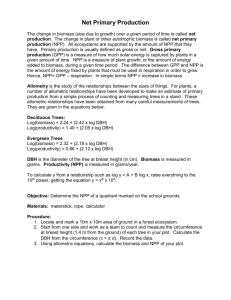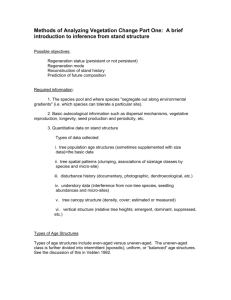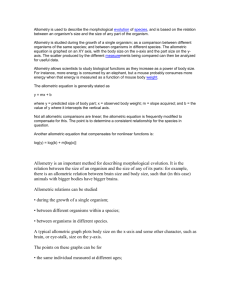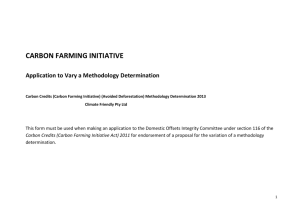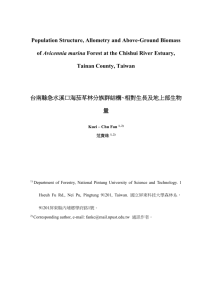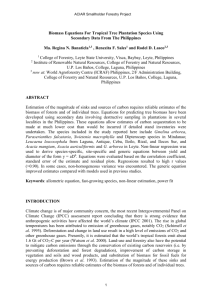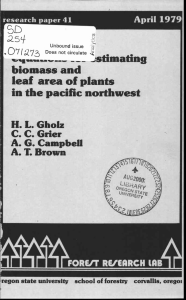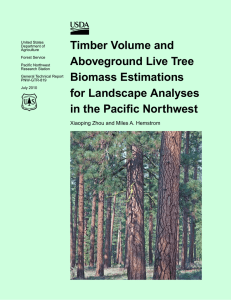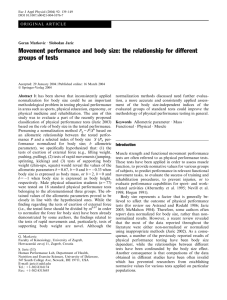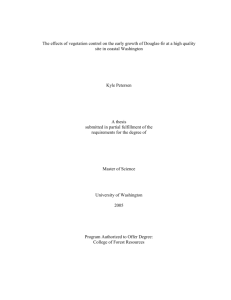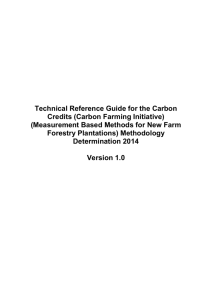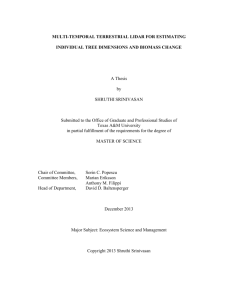Electronic Supplementary Material Calculation of carbon in living
advertisement
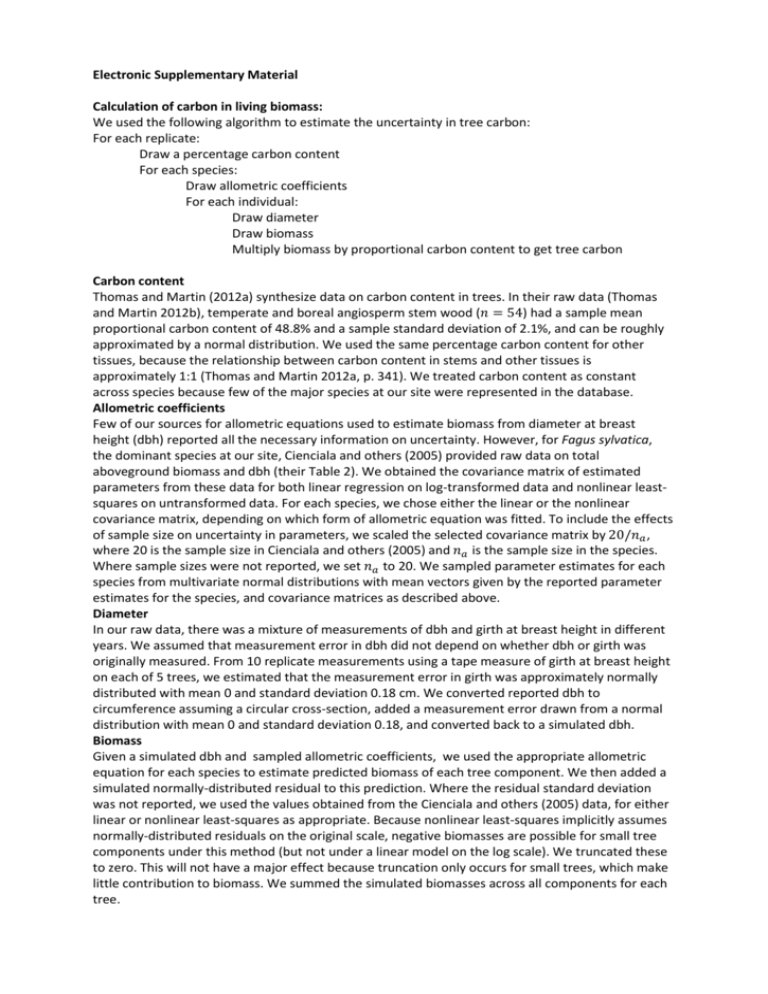
Electronic Supplementary Material Calculation of carbon in living biomass: We used the following algorithm to estimate the uncertainty in tree carbon: For each replicate: Draw a percentage carbon content For each species: Draw allometric coefficients For each individual: Draw diameter Draw biomass Multiply biomass by proportional carbon content to get tree carbon Carbon content Thomas and Martin (2012a) synthesize data on carbon content in trees. In their raw data (Thomas and Martin 2012b), temperate and boreal angiosperm stem wood (𝑛 = 54) had a sample mean proportional carbon content of 48.8% and a sample standard deviation of 2.1%, and can be roughly approximated by a normal distribution. We used the same percentage carbon content for other tissues, because the relationship between carbon content in stems and other tissues is approximately 1:1 (Thomas and Martin 2012a, p. 341). We treated carbon content as constant across species because few of the major species at our site were represented in the database. Allometric coefficients Few of our sources for allometric equations used to estimate biomass from diameter at breast height (dbh) reported all the necessary information on uncertainty. However, for Fagus sylvatica, the dominant species at our site, Cienciala and others (2005) provided raw data on total aboveground biomass and dbh (their Table 2). We obtained the covariance matrix of estimated parameters from these data for both linear regression on log-transformed data and nonlinear leastsquares on untransformed data. For each species, we chose either the linear or the nonlinear covariance matrix, depending on which form of allometric equation was fitted. To include the effects of sample size on uncertainty in parameters, we scaled the selected covariance matrix by 20/𝑛𝑎 , where 20 is the sample size in Cienciala and others (2005) and 𝑛𝑎 is the sample size in the species. Where sample sizes were not reported, we set 𝑛𝑎 to 20. We sampled parameter estimates for each species from multivariate normal distributions with mean vectors given by the reported parameter estimates for the species, and covariance matrices as described above. Diameter In our raw data, there was a mixture of measurements of dbh and girth at breast height in different years. We assumed that measurement error in dbh did not depend on whether dbh or girth was originally measured. From 10 replicate measurements using a tape measure of girth at breast height on each of 5 trees, we estimated that the measurement error in girth was approximately normally distributed with mean 0 and standard deviation 0.18 cm. We converted reported dbh to circumference assuming a circular cross-section, added a measurement error drawn from a normal distribution with mean 0 and standard deviation 0.18, and converted back to a simulated dbh. Biomass Given a simulated dbh and sampled allometric coefficients, we used the appropriate allometric equation for each species to estimate predicted biomass of each tree component. We then added a simulated normally-distributed residual to this prediction. Where the residual standard deviation was not reported, we used the values obtained from the Cienciala and others (2005) data, for either linear or nonlinear least-squares as appropriate. Because nonlinear least-squares implicitly assumes normally-distributed residuals on the original scale, negative biomasses are possible for small tree components under this method (but not under a linear model on the log scale). We truncated these to zero. This will not have a major effect because truncation only occurs for small trees, which make little contribution to biomass. We summed the simulated biomasses across all components for each tree. Bias correction: Temperature and radiation For the overlapping period in two datasets, a linear model was fitted to the relationship between daily values from each dataset, using the dataset to be bias corrected as the explanatory variable. The coefficients from this model were then applied to daily values in the non-overlapping part of the dataset to be bias corrected. Precipitation For the overlapping period in two datasets, the monthly mean value across all years (climatology) was calculated for each dataset. Values for the reference dataset were then divided by values for the dataset to be bias corrected, to give proportional differences for each month. Daily values in the non-overlapping part of the dataset to be bias corrected were then multiplied by these differences. Figure A1 Top panel: De-trending Temperature was de-trended by fitting a linear model (blue line) to annual means (red bars) for each month separately. This example uses temperatures for May. The difference between the predicted monthly mean and each daily value was then calculated (sum of daily variation: red arrows and monthly variation: blue arrows) and added to the predicted monthly mean for 1961 (blue dot), thereby maintaining intra-annual variability. Left panel shows data before de-trending and right panel shows data after. It should be noted that while the top panel shows a truncated range of years, the linear models were fitted to all years in the local station dataset (1961-2005). Bottom panel: Calculating anomalies The mean of daily values (black dots) across years 1970-2005 was calculated for each month separately to generate a climatology (blue line). This example uses temperatures for May. Monthly anomalies (blue arrows) in each future year were calculated as the difference between the future month mean (red bars) and the climatology (blue line, dashed in future years) for each climate variable. For temperature (shown here) this was calculated by subtracting the climatology from the future monthly mean (delta change method). For precipitation and radiation this was calculated by dividing the future mean by the climatology (multiplicative relative anomalies). These anomalies were then added to or multiplied by the relevant daily values to give future climate daily data. Figure A2 The effect on carbon storage of changing either temperature (above) or precipitation (below) in isolation. Temperature was modified by adding or subtracting degrees to each daily climate value, whereas precipitation was changed multiplicatively since it is a zero based variable. References Cienciala, E., Ćerný, M., Apltauer, J. and Exnerová, Z. (2005). Biomass functions applicable to European beech. Journal of Forest Science 51:147-154. Paletto, A. and Tosi, V. (2010). Deadwood density variation with decay class in seven tree species of the Italian Alps. Scandinavian Journal of Forest Research 25:164-173. Thomas, S.C. and Martin, A.R. (2012a). Carbon content of tree tissues: a synthesis. Forests 3:332352. Thomas, S.C. and Martin, A.R. (2012b). Dryad wood carbon content database. Available online: http://dx.doi.org/10.5061/dryad.69sg2 (accessed on11 December 2013).
